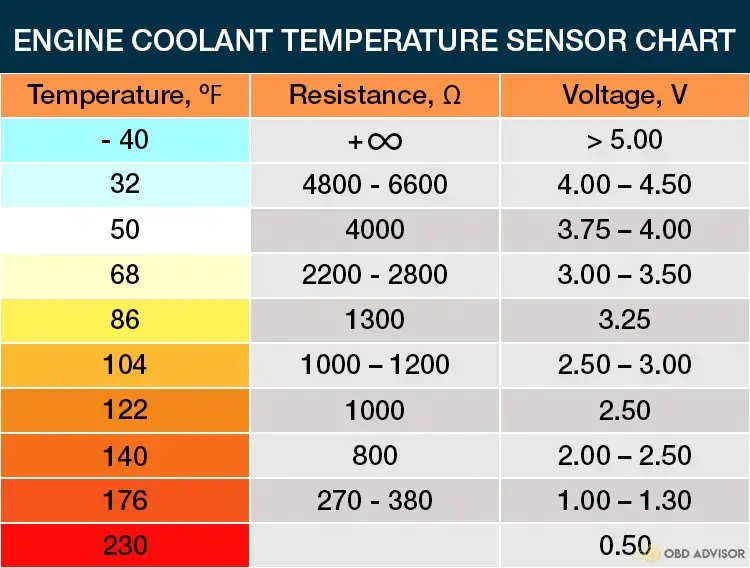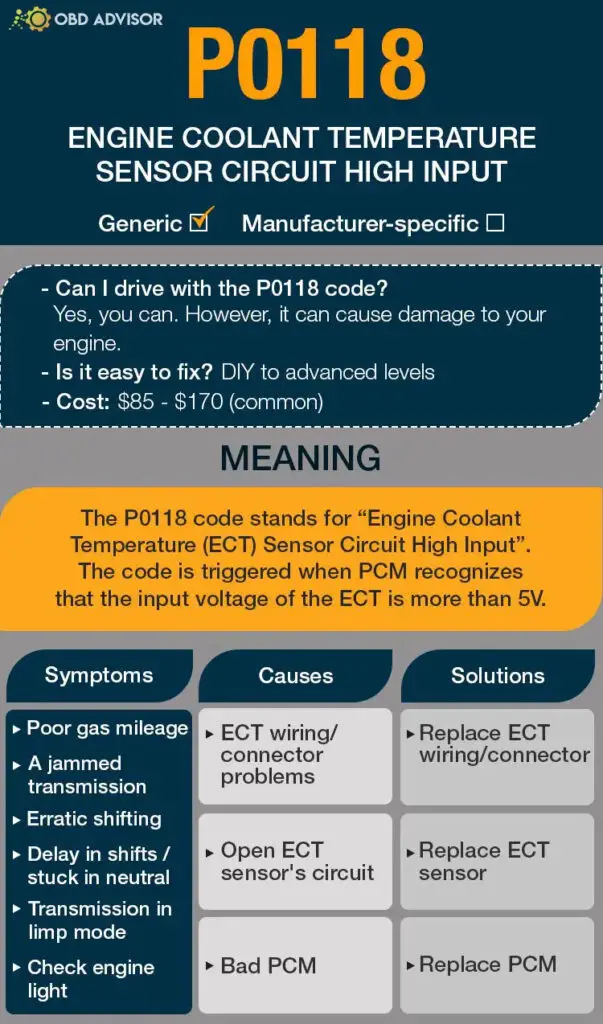P0118: Engine Coolant Temperature Sensor Circuit High Input
Suppose you are driving down the road, and your check engine light turns on, displaying a P0118 code error!
Well, you read that using an OBD scanner, but what next?
Let’s discuss your situation in this article.
- P0118 Definition: Engine coolant temperature sensor circuit high input problem.
- Code type: Generic – P0118 indicates the same problem whether you’re having a Chevy, Honda, Dodge, etc.
- Can I drive with the P0118 code? Yes, you can. However, it may cause damage to your engine in the long term.
- It is easy to fix? DIY to advanced levels.
- Cost: $85 – $170 (common).
To help you understand the P0118 code, I have split this article into four parts: causes, symptoms, how to diagnose, and how to fix the P0118 code.
Read further and unveil everything you need to know about the P0118 and its quick fixes.
What Does the P0118 Code Mean?
The P0118 code stands for “Engine Coolant Temperature (ECT) Sensor Circuit High Input”. The code is triggered when PCM recognizes that the input voltage of the ECT is more than 5V.
The ECT sensor measures the engine coolant temperature. This data is sent to the powertrain control module (PCM) to control the cooling system.
Under good conditions, the higher the temperature, the lower the ECT sensor voltage. This number ranges from 0.5 to 4.5V.

As mentioned above, the code P0118 is set when the ECT voltage is higher than 5V. This means the PCM is receiving a “too cold” signal (-40F). Of course, the PCM knows this signal is abnormal and does not believe in it (if it did, the thermostat would close, leading to an overheating engine.)
As a result, P0118 makes your car enter failsafe mode to prevent the engine from overheating.
In this mode, the cooling system is allowed to run at maximum capacity, which includes:
- Radiator constantly running.
- Wide-open thermostat.
- AC off.
Consequently, the car takes more time to warm up. This reduces fuel economy and damages the engine parts in the long run.
Other codes may appear with P0118: P0115, P0116, P0117, and P0119.

P0118: Causes, Symptoms, and How To Fix
Causes #1: ECT Wiring/Connector Problems
In many cases, P0118 is caused by the ECT sensor connection problems in the wiring harness or inside the connectors.
The symptoms of this problem are shown by:
- Erratic temperature gauge readings.
- Malfunctioning air conditioner.
- Radiator fans running constantly.
- High fuel consumption.
- Hard start.
- Check engine light on.
- Black smoke from the engine.
- Poor idling.
If this is the case, repairing the wiring harness will fix the problem.
Causes #2: Open ECT Sensor’s Circuit
If the wiring is fine, the circuit inside the ECT sensor can be open for various reasons, which leads to the P0118 popping up.
The symptoms of a bad ECT sensor are the same as the ECT wiring/connector causes.
In this case, replacing the ECT will fix the P0118.
Read more: P0172: System Too Rich (Bank 1)
Causes #3: Faulty PCM (Rare)
The powertrain control module (PCM) is the main engine computer that ensures your engine transmission works effectively. So, a faulty PCM can be a potential cause of the P0118 code, although it rarely occurs.
Also, there are combination codes with P0115 and P0117 associated with faulty PCM in some cases.
You can repair faulty PCM by reprogramming it, although that won’t be effective in the long run.
So, replacing the PCM would be the best option.
P0118 Causes Identification: How to Diagnose
As mentioned above, in most cases, there are 2 main causes triggering the P0118 code:
- The ECT wiring harness.
- The ECT sensor itself.
The question is: “Which one?”
Continue reading to reveal how you can diagnose the cause of the P0118 code.
Diagnosing ECT Wiring/Connector Problems
First, locate the sensor and visually inspect its wiring to check if there are any burnt, broken, or unplugged wires and fix them.
If there isn’t, use a multimeter to check the wiring harness. Here are the steps to do so:
- Unplug the cables connecting the sensor.
- Turn on your vehicle’s ignition key without starting the engine.
- Connect the multimeter red clip to the positive terminal and the black clip to the ground wire.
- Record the multimeter readings. Your sensor wiring has a problem if your multimeter registers a zero ohm reading. Slightly more than zero ohms multimeter reading should be good wiring.
Diagnosing Open ECT Sensor’s Circuit
If all the wires are good, the ECT itself is very likely to be the problem.
Here’s how you can test it:
- Locate the ECT sensor: near the thermostat in the cylinder head or block or on the thermostat housing.
- Remove the sensor wiring connectors while the engine ignition is off.
- Connect an ohmmeter between the sensor terminals. Measure and record the resistance.
If the ohms reading is more than 6600Ω or infinity, the sensor’s circuit is open and needs a replacement.
Diagnosing Faulty PCM
After testing the ECT sensor and circuit problems and there aren’t any problems with these, a bad PCM should be the last conclusion.
However, this is a rare cause.
Having a mechanic handle it is the best solution in this case. And it’s not cheap!
How Much Does It Cost to Fix the Code P0118?
Most P0118 causes can be fixed by yourself with a few bucks.
For example, the ECT sensor can cost you $10 to $30.
Most Auto shops charge the cost of fixing code P0118 in terms of the hours for the work.
Although the charges vary from shop to shop, you can expect to spend between $85 and $170, excluding the cost of the parts.
The estimated repair cost of the P0118
| Solutions | Repair cost |
|---|---|
| Repairing ECT wiring / connector problems | DIY: a few bucks Mechanic: $85 to $170 |
| Replacing malfunctioning ECT sensor | DIY: $10 to $30 Mechanic: $85 to $170 |
| Replacing faulty PCM | DIY: Not recommended Mechanic: $1000 to $3000 |
Note: The data in this table is dated June 2022. The exact cost will depend on various factors such as mechanic rates, car model, etc.
You Ask, I Answer
Hopefully, this article explains why you are getting the P0118 and how you can find the best solution that saves you money.
If you have any other concerns about the P0118 code, don’t hesitate to comment below, and I will be quick to answer.
Also, you can help someone by sharing what you did in case you had this code before.
Let’s all have a safe and risk-free drive!
Read more: The 9 Best OBD2 Scanners for 2024: The Only Review You Need
